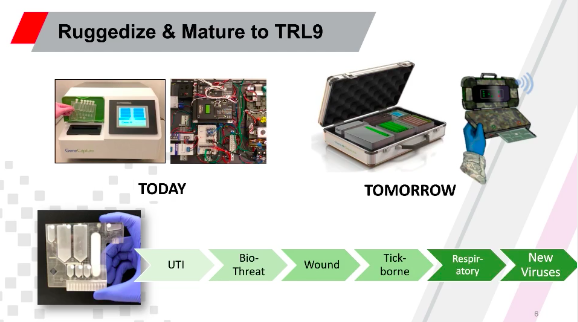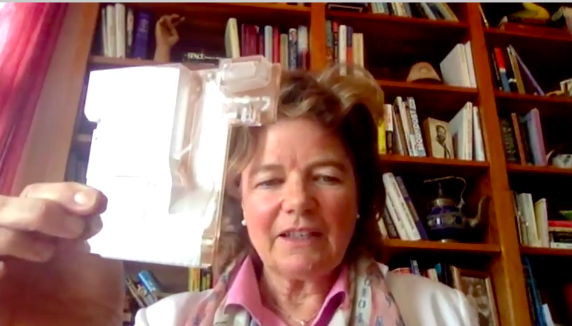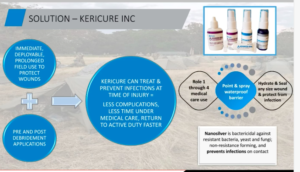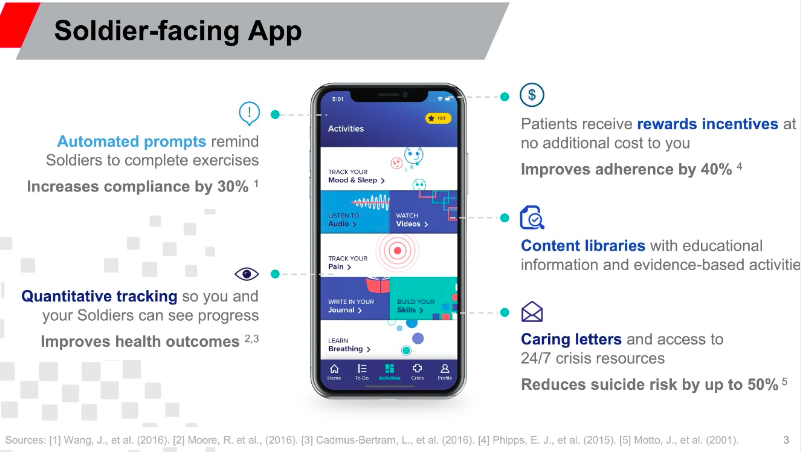
GeneCapture wants Army funding to help turn its microwave-sized scanner into a portable unit capable of testing for 200 diseases in 60 minutes.
WASHINGTON: A portable scanner that checks throat swabs and blood samples for dozens of different pathogens in 60 minutes. Sprayable sealant for wounds that kills germs with nanoscopic particles of silver. A mental health app that tracks the user’s state and pushes out tailored tips and resources for, as an example, dealing with coronavirus-induced isolation.
These were just the first three pitches I saw yesterday when I tuned in to the Army’s webcast of its xTechSearch 4 pitches. Originally planned to happen before a live audience at AUSA’s Global Force conference in Huntsville, they’re now running online this week as a social distancing precaution.
[Click here to read all our coverage of virtual & surrogate AUSA Global 2020 events]
The Army already has the lion’s share of the Defense Department’s medical assets, since it has both the most personnel and the biggest role in humanitarian disaster response, and the service is playing a leading role in the government-wide response. It’s also eagerly pursuing new technology.
The 2020 edition of Army’s Shark Tank-style competition for innovative technologies – with $1.7 million in prizes at stake this year, $1.2 million in this week’s round alone – started long before COVID-19 broke out in Wuhan, China. But with the Army acutely interested in advanced medical science, it’s understandable that several of the competitors are working on projects relevant to the coronavirus.
[UPDATED: Of the three companies in this story, two — GeneCapture and KeriCure — won $120,000 prizes and the right to proceed to the finals at the AUSA annual convention in October (assuming that isn’t canceled), the Army announced Thursday. The third, NeuroFlow, did not, perhaps because they already have extensive financing from other sources].

GeneCapture CEO Peggy Sammon holds up a disposable cartridge used for testing samples for dozens of pathogens at once.
GeneCapture & KeriCure: War On Germs
One of the biggest problems in countering COVID-19 is the shortage of test kits. With a long incubation period, often-ambiguous symptoms, and many of the infected apparently completely asymptomatic, the only way to figure out who’s actually carrying the virus is to run a lab test that’s specifically developed to look for that one pathogen. That can take two to three days even if a test kit is available – which it usually isn’t at the moment, for either US servicemembers or civilians. Developing some kind of rapid diagnostic device is a high priority for public health in general, with the Theranos fraud case the most recent high-profile failure, but a small Huntsville company called GeneCapture believes they’ve cracked the (genetic) code.
“In 60 interviews with medics… every medic we talked to has a story about an infection that just went wrong and the horrors of trying to deal with that in field,” CEO Peggy Sammon told the xTechSearch panel yesterday. While infectious disease no longer kills more soldiers than combat, as it did until the 20th century, it still hospitalizes more servicemembers than do battle wounds, and 30 percent of battle wounds get infected anyway. (War zones, unsurprisingly, are unsanitary). So the ability to rapidly check samples for signs of infection would be as valuable for combat medics as for civilian doctors.
Instead of looking for one virus or bacterium at a time, GeneCapture’s device can process a sample – blood, urine, saliva, and throat swabs all work – and look for the tell-tale genetic traces of 60 different pathogens. That’s up from 40 a few months ago, with more being added all the time. The company’s goal is to check for 200 bacteria, viruses, and fungi in 60 minutes.
200 is a fairly arbitrary number, Sammons said, driven by the size of the disposable plastic cartridge used for each test and the miniaturized “micro-array” that does the actual testing. But, she added, it works well with the fact that just 160 known pathogens cause most infections worldwide.
Adding a new pathogen to the array, she said, would be a matter of weeks once someone, somewhere sequences its genetic code, which is now standard operating procedure for new diseases. (Multiple strains of COVID-19 have already been sequenced by researchers around the world).
What about viruses that mutate every year, like the flu, or genetically engineered bioweapons that don’t match any natural pathogen? The device doesn’t need to match 100 percent of the RNA or DNA in the sample to a known bacterium, fungus, or virus, Sammons said. Instead, it looks for crucial pieces of genetic code that don’t mutate rapidly – some of which, she said, have remained unchanged for millions of years and would be present in any strain, whether naturally mutated or artificially engineered.
The device also does its scan in about an hour, compared to multiple days for current one-pathogen-at-a-time lab tests. That means you don’t need to refrigerate the sample or ship it anywhere, Sammon said, just collect it and test it on the spot. With a wireless connection, you could feed the result directly into public health databases in real time. And the tests are accurate. The prototype agrees with “gold standard” tests from medical labs 95 percent of the time. (In technical terms, they achieved 90 percent sensitivity, 100 percent specificity, and a 95 percent match).
Now, that prototype isn’t portable, not yet. It’s the size of a microwave oven and runs off an electrical outlet in GeneCapture’s lab. That’s what the company wants the Army’s help with. “The science part of this is done,” Sammon said. “What we need now is to ruggedize and mature our prototype to a TRL 9” – Technological Readiness Level 9, DoD jargon for a technology proven in successful real-world use.

KeriCure is a spray-on sealant that kills pathogens already in a wound and then protects it from further infection.
Now, faster testing is great, but ideally, you’d avoid getting infected in the first place. Much of the world is currently on lockdown trying to avoid contagion, but many pathogens enter the body through wounds. It’s a particular problem for soldiers on battlefields, field exercises, and forward outposts, which are notorious for mud and dust, not cleanliness.
That’s where KeriCure comes in. Founder Kerriann Greenhalgh (yes, she named it after herself) started work on a spray-on wound sealant as a graduate student, focusing on burn injuries. She realized it had wider applications after her own husband hurt his hand and the injury became badly infected. The key, she explained, was developing a material that can be sprayed over the wound to seal it and then stay there, without peeling off or cracking as the body moves. KeriCure is formulated to have the same flexibility as human skin, she said.
It also includes lidocaine for pain management and an infusion of tiny silver nanoparticles, which can kill bacteria and – unlike anti-bacterial agents – viruses as well. And the spray can be compact enough for an individual soldier or civilian to carry and use, without waiting for a medic.

The NeuroFlow app
NeuroFlow: Software vs. Suicide
One of the xTechSearch candidates, NeuroFlow, has already done something to help with COVID-19, albeit with the mental health consequences of the outbreak rather than the virus itself. The company’s website offers care providers tools to keep in touch with their patients without physically being in touching distance. And the NeuroFlow software recently pushed out “anti-anxiety and social isolation content” to users at risk of depression during the COVID-19 quarantine or self-isolation, said the company’s CEO, Chris Molaro.
NeuroFlow is, at its core, an AI-driven approach to suicide prevention – an issue of intense concern to both Army leaders and Molaro, who commanded a platoon in Iraq.
“The biggest leadership failure of mine [was] a soldier took his own life,” Molaro said on yesterday’s webcast. The unit was aware the soldier was under stress, and they tried to get him to seek care – but the soldier never actually got it.
“That soldier never followed up with care,” Molaro said. “He was referred [to care], but no one in his chain of command or his care team followed up.” That’s all too typical, he said: two-thirds of people referred for behavioral health care never follow up.
NeuroFlow is about making it easier for the stressed, the traumatized, and the depressed, who often struggle to reach out for help, to get the care they need. The Defense Department, the VA, and nonprofits have a host of resources available for mental health, Molaro explained, but figuring out which one to turn to and how to get there can be overwhelming for those most in need. Shame and stigma, especially in toughness-driven cultures like the military, can it daunting just go to an appointment: Sure, what you say to your care provider is confidential, as are any drugs you take, but your fellow soldiers can see you walk into the base’s behavioral health clinic and draw their own conclusions. And forward-deployed troops may not have access to any counseling.
Schematic of how NeuroFlow monitors a (fictional) patient for rising mental health risk and intervenes.
So NeuroFlow puts all those resources in your pocket, with an app. It also monitors the user’s emotional state through a series of interactive features – designed with the same psychological tricks as online games to keep you engaged and clicking in ways a formal self-assessment never could. In the first few weeks of a rollout earlier this year to 3,000 Philadelphia fire fighters and other first responders, Molaro said, “our algorithms picked up 15 high-risk cases, [and] we were able to route them to the appropriate self-care measures [and] crisis resources.”
Wouldn’t some people just lie to the app about how they feel, the Army reviewers asked, just as they sometimes lie to their doctors? That’s possible, Molaro and his team says, but research shows people are much more candid with an app than they are in a clinical setting.
The back-end of the software provides reports to healthcare providers and – on an anonymous, aggregated basis to protect individual privacy – to employers and commanders trying to monitor the overall health of their workforce. (The privacy protections for users were a major focus of the Army reviewers’ questions).
NeuroFlow has raised $11 million in venture capital, Molaro said, and it’s working with 900 care providers and multiple large organizations, including the VA and the Navy. But you can’t just take the VA, Navy, or Philadelphia Fire Department versions and clone them for the Army.
“The Army is unique in many ways,” Molaro said. That’s why he’s asking for xTechSearch funds to do in-depth onsite discussion with Army leaders, soldiers, and medical professionals on how to tailor the software to their needs. The goal: roll out an Army version to an operational unit in 2021.
Questions hang over UK’s new, ambitious defense spending plan: Analysts
Such is the scale of British Army acquisition problems alone that they could not be resolved if the UK moved to a long term spending settlement of even 4 percent GDP, an expert told British lawmakers.


























